Overview
The problem with bringing together a wealth of different delivery methods is that each delivery technology tends to come with its own client to install on the target device, with AppsAnywhere itself being no exception! If we were to expect the user to install all of the clients that were required themselves and keep them all up to date then the support team would be inundated with requests for help. To remove this burden from the user, we have built AppsAnywhere to completely automate the version control for all third-party clients and update itself as and when required; we call it "Advanced Client Management".
This functionality basically allows you, as the administrator, to define exactly which clients you want to be installed on the user's device and which versions you want them to be using. AppsAnywhere and the AppsAnywhere Client handle the rest.
What's Included?
At the moment, the advanced client management includes the AppsAnywhere Windows Client (and its associated updater app), the AppsAnywhere Mac Client and all of the third-party clients required by the delivery technologies AppsAnywhere is currently integrated with. As it currently stands, this includes:
-
Cloudpaging Player (Windows)
-
VMware Horizon (Windows)
-
VMware Horizon (macOS)
-
Parallels Client (Windows)
-
Parallels Client (macOS)
-
Microsoft Remote Desktop client (Windows)
-
Microsoft Remote Desktop client (macOS)
How does it work?
At AppsAnywhere HQ, we store a central repository of each version of every client that is managed by the system. The information relating to which clients are available is then made available to each AppsAnywhere installation via a global API. When you visit the Client Settings in page in AppsAnywhere, AppsAnywhere contacts the central API and retrieves the latest version information for each product. Each product is then listed on the page shown below and the most recently released version is shown on the far right-hand side, along with an indication of whether or not you are using that version.
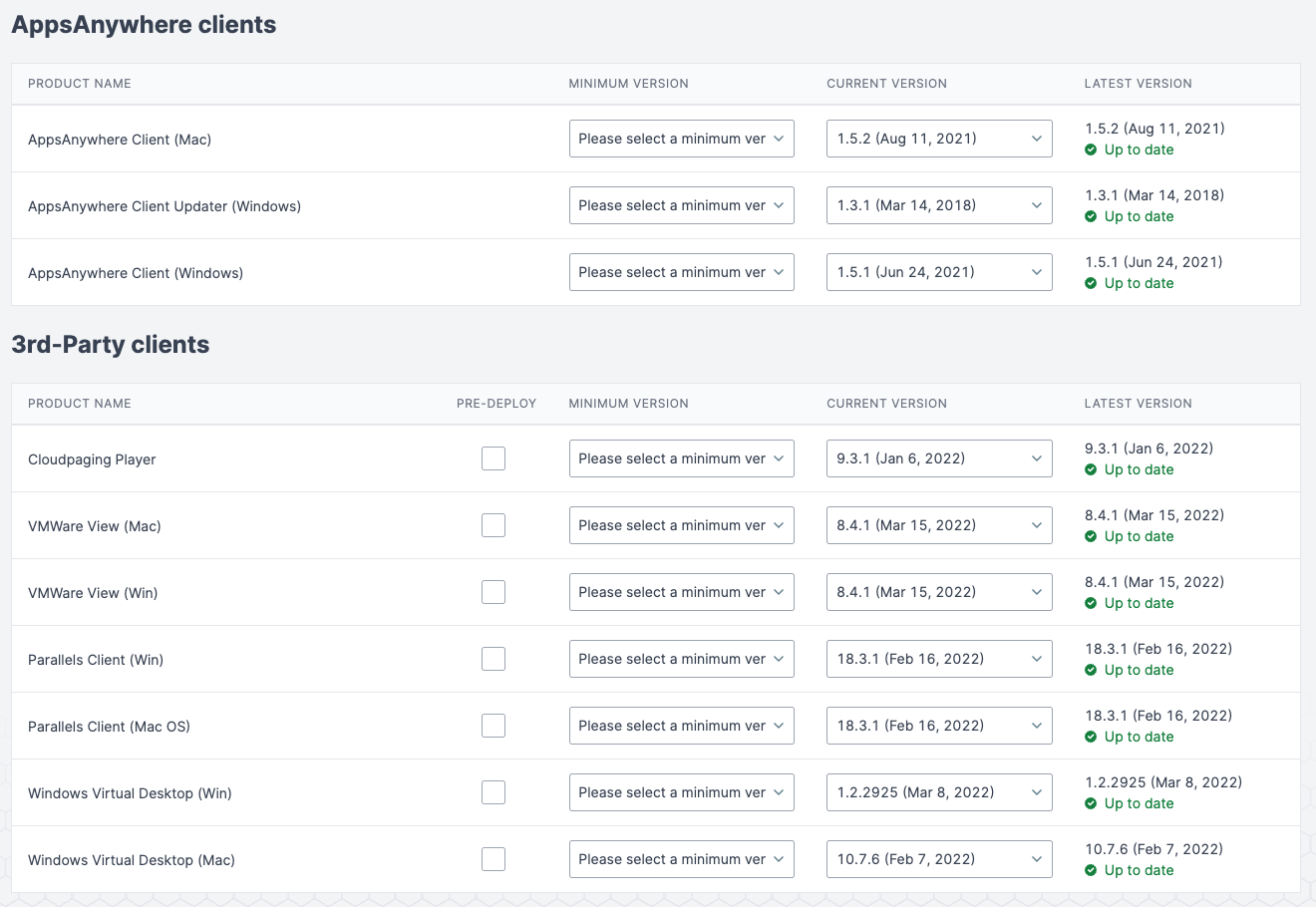
You then have the ability to choose which version you wish to be used with your installation.
Current Version
The version you select as the "Current Version" is the one you wish to be deployed to your end users if they haven't already got that particular product. When you select a new current version, AppsAnywhere will download the installers for that version of the product and save them to the public/downloads folder on your server so that the client can download it, as required, from your AppsAnywhere server. If you have more than one AppsAnywhere server setup then AppsAnywhere will also instruct those other servers to do the same so that the file is available from all servers (See Server Clustering).
Minimum Version
The version you select as the "Minimum Version" dictates at what point a user will be upgraded if they already have a version of the product installed. The AppsAnywhere client will compare the installed version of each product to the minimum version set and if the installed version is older than the minimum it then it will upgrade the product to the “Current Version”. Changing this value could potentially result in all of your users being upgraded to the Current Version.
Pre-Deployment
For each third-party client, you can decide whether or not you want it to be installed by default when the user installs AppsAnywhere.
-
With the Pre-Deploy checkbox Checked
-
The product will be installed straight after the AppsAnywhere client installation completes (as AppsAnywhere initializes for the first time) ready for the first time someone wishes to use an app that requires that client
-
-
With the Pre-Deploy checkbox Un-Checked
-
The product will be installed the first time the user tries to launch an app that requires it
-
There is an obvious trade-off between slowing down the initial installation time and not delaying the user when they launch an app for the first time. You should consider which third-party clients your users are most likely to require and consider these for pre-deployment whilst maybe leaving those that are less likely to be used to be installed when required.
What will the End User See?
Whichever way you intend to update the AppsAnywhere the process will look similar to the below for the end user.
In this example the end user has the 1.3.8 version of the client installed on their device:

If an administrator changes the ‘minimum version’ in the dropdown menu to the latest version available in this case 2.0.2 the administrator will receive the following prompt to confirm the changes.

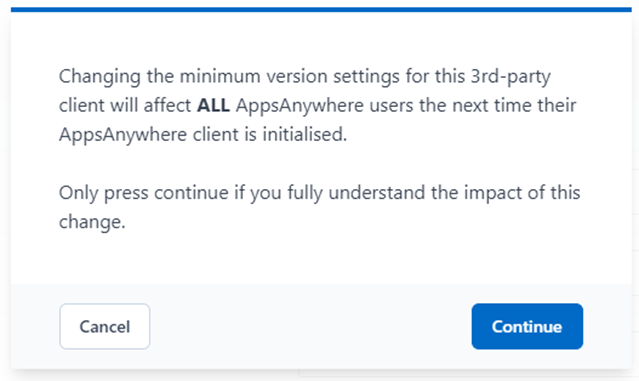
Select continue to proceed with this change.
The next time the end user logs into AppsAnywhere the new client will be pushed out depending on the client install suppression settings. See Client Install Suppression settings.
See the older 1.3.8 version of the AppsAnywhere client updating to the new 2.0.2 version.
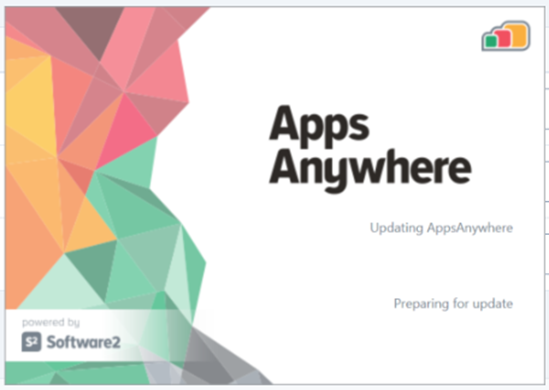
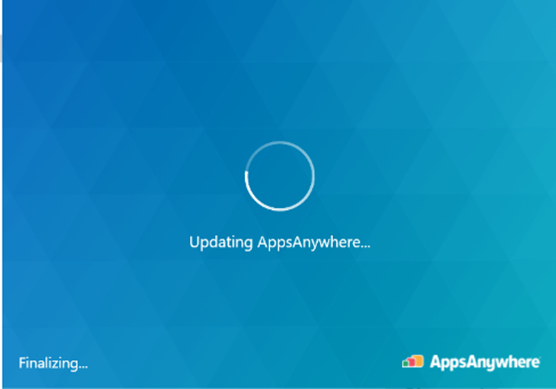
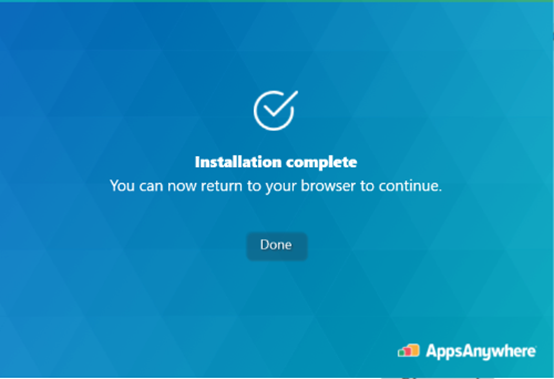
Once the installation has completed the end users should then be able to re validate and continue using AppsAnywhere.
Syncing Between Servers
Whenever a change is made on the client settings page, AppsAnywhere instructs all other servers in the cluster (defined under Environments > AppsAnywhere Servers) to apply the same update. If you have changed the current version of a client, this will have resulted in that version being downloaded from the Software2 CDN to the server on which you made the change. Once the server has the file, it will instruct each of the other servers to download that file from the initiating server so that it exists on all servers and is available for download. Each of the other servers in the cluster will download the file from the initiating server using its defined hostname over HTTP.
When do updates happen?
Self-updates
Windows client
Upgrades to AppsAnywhere are performed by the Updater Scheduled task, which runs at a random time each day.
macOS client
Upgrades to AppsAnywhere are performed by the Launch Agent, which runs at a random time each day.
Third-party client updates
Client version 1.x
-
With the Pre-Deploy checkbox Checked
-
Updates for the third-party client will be installed when the AppsAnywhere client starts
-
either at logon or;
-
The first time AppsAnywhere is used for each login session
-
-
-
With the Pre-Deploy checkbox Un-Checked
-
Updates for the third-party client will be installed the next time the user tries to launch an app that requires that client
-
Client version 2.x (Client v2.0.0 and above)
-
With the Pre-Deploy checkbox Checked
-
Updates for third-party clients will be installed automatically in the background when they are not running
-
The client checks for new third-party client updates once every 24 hours
-
If the third-party client is running then the update is retried every hour until it is installed
-
If a newer version of the third-party client is available when the next update check occurs, the newer version will be installed
-
-
-
With the Pre-Deploy checkbox Un-Checked
-
Third-party client updates will be installed the next time the user tries to launch an app that requires that client
-